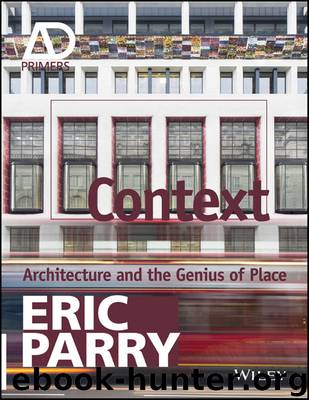Context by Parry Eric

Author:Parry, Eric
Language: eng
Format: epub
ISBN: 9781118946749
Publisher: Wiley
Published: 2015-05-08T04:00:00+00:00
Eric Parry, perspective sketch of Chamberlin, Powell and Bon’s Golden Lane Estate, 2014
Sketch of the ground and lower-ground levels showing the community centre, swimming pool and sports club, tennis courts, shopping arcade and pub.
Under Great Arthur House is the estate office which also, given the small size of the maisonettes and flats (58 square metres (620 square feet) for a two-bed), runs a scheme providing a number of apartments for short-term and overnight accommodation for residents’ relatives and friends at economical rates. The space to the east of Great Arthur House, marked Central Piazza on Powell’s competition plan, is bounded by the community building, a generous 22-by-15-by-4-metre (72-by-49-by-13-foot) room with a bar and stage used for parties, weekly chess tournaments, tenant meetings and bring-and-buy markets, above a more conspiratorial bar at lower-garden level.
The garden structure is naturally more public at street level and, through the use of the basement level of the pre-war buildings, more private at lower ground. To the east of the community building is a robust water and rose garden, while the ground-floor maisonettes have stepped access to the lower gardens. All the buildings have lock-up storage at basement level. The complex fragmentation leads naturally to a limit of deck lengths and therefore the self-policing of the close knowledge of neighbours rather than the one-liner and highly debatable continuous ‘streets in the air’ championed by Alison and Peter Smithson’s competition entry for Golden Lane, which was then widely publicised in the press.
The graduation from the public bustle of Goswell Road to the reflective quiet of Golden Lane itself is carefully calibrated, as is that from the openness of the southern perimeter to the relatively closed northern edges of Baltic Street West and East. The architecture is, like the austerity-driven magic of Finnish post-war furniture and building design, simple and elegant. The warp buildings are all constructed of a brick and a half-thick sequence of dividing fin walls of five, six and seven storeys. These have subtle adjustments in line and contain the lightweight panels and aluminium window sections to the south. Brick turns to concrete in the tower topped by its distinctive roof garden and water tanks – like the hood of a windswept nun.
The weft buildings are on pilotis, and the staggered placing of the warp buildings opens up wonderful diagonal views like the pattern of a Mondrian risen from the pavement to form an integral part of urban design: intense simultaneous frames, views and colours – quite brilliant.
The contained architectural and urban control of the Golden Lane Estate becomes distinctly more problematic when seen as one of a complex series of urban territories that constitute its neighbourhood. The gleaming new estate stood in stark contrast to the adjacent buildings. To the south the patchwork of bombed-out sites running to St Paul’s Cathedral and the river would form the most radical of London’s post-war urban laboratories, creating London Wall, the Barbican Estate, Paternoster Square and the Museum of London. To the west across Aldersgate lies one
Download
This site does not store any files on its server. We only index and link to content provided by other sites. Please contact the content providers to delete copyright contents if any and email us, we'll remove relevant links or contents immediately.
Kathy Andrews Collection by Kathy Andrews(11326)
The remains of the day by Kazuo Ishiguro(8395)
Paper Towns by Green John(4800)
Spare by Prince Harry The Duke of Sussex(4788)
Industrial Automation from Scratch: A hands-on guide to using sensors, actuators, PLCs, HMIs, and SCADA to automate industrial processes by Olushola Akande(4604)
The Body: A Guide for Occupants by Bill Bryson(4585)
Be in a Treehouse by Pete Nelson(3648)
Machine Learning at Scale with H2O by Gregory Keys | David Whiting(3627)
Harry Potter and the Goblet Of Fire by J.K. Rowling(3609)
Never by Ken Follett(3528)
Goodbye Paradise(3446)
The Remains of the Day by Kazuo Ishiguro(3139)
Into Thin Air by Jon Krakauer(3131)
The Cellar by Natasha Preston(3077)
The Genius of Japanese Carpentry by Azby Brown(3040)
Fairy Tale by Stephen King(2949)
120 Days of Sodom by Marquis de Sade(2941)
Drawing Shortcuts: Developing Quick Drawing Skills Using Today's Technology by Leggitt Jim(2940)
The Man Who Died Twice by Richard Osman(2808)
